Hey y'all,
Just bought my dream offset smoker as a HUGE jump from the Weber Kettle I used to smoke on (Snake method for those curious). And I did my first cook on it just a couple days ago, want to share here the experience and also discuss about my learnings.
Equipment: Franklin Pit, shovel for fire management.
Meat: 9lb (post trim) choice grass fed grain finished brisket. Bought at Golden Steer (WA state)
Wood: Hickory kiln dry (very important for later discussion)
Spray: 50/50 water and apple cider vinegar.
Rub: Goldees BBQ rub, bought it on my trip to Dallas.

Initiating the fire:
As I said before, I bought some kiln dry hickory wood from Amazon without knowing much about seasoned wood or being very well versed on fire management when it relates to wood. I wanted to have a wood coal base for maximum natural flavor (does it really matter though?) so I started off with a Lincoln cabin. HUGE MISTAKE! Well, not the method itself, but how I built it. I did a 3 level Lincoln cabin... of kiln dry wood... I learned the tough way the difference between naturally seasoned and kiln dry, how much hotter and faster it burns. Took me an hour to get it down from 700+ F. So, my cook started at around 12PM and it was a constant fight with big spikes.

Early cook:
While cooking I was watching at YouTube videos on fire management, huge shutouts to YouTube channels Fatty's Feasts, Meat N' Greet BBQ, Meat Church and Mad Scientist BBQ for having very useful videos! So, my spikes were mostly at around 325F and my cooking average was at 275F. I was going for a bit more of an aggressive cook to get familiar with the smoker and to avoid dips, I felt more confident keeping a fire hot than trying to resuscitate it as I knew I would overblow it. First spray came in at 2h cook time and then spray every 30-45 minutes.
Wrapping Time:
I wrapped at the 9h mark at 175F with a good bark, used beef tallow I had rendered before to keep the moisture content, not much to tell about this part, up until here everything was kinda smooth sailing. The bad thing is that at this point I had used up all 2lbs of my kiln dried hickory wood, and in retrospect I should have finished it in the oven, but I wanted to go all the way in the smoker so I just wrapped and put it back (Sorry for the lack of pictures, I was honestly more worried at this point about learning)
Finishing the cook:
I finished the cook with the brisket wrapped in butcher paper and using some NATURALLY seasoned wood I had in my backyard, now here is my big mistake, I treated it the same way I treated the kiln dry up until this point, so I thought I needed just one log or so and replace every hour or so. BIG mistake, I was struggling to keep the temperature above 220F and every time I tried to manage the fire and make things hotter I would just introduce more cold air. Keep it mind at this point it's 11pm in Seattle area, so it got very cold. I ended up reaching 202F internal at 3.30AM, yeah, I effed up big time my dips at the end when changing types of wood. Lesson learned.
Rest:
I rested my brisket on a Coolman warmed up with boiling water, with a couple damp towels and wrapped in foil to decrease rate of temperature drop, at the 8h mark it reached bellow 140F, so it was time to eat.




It was very juicy, tender, passed the finger test and the pull test without being overcooked. I feel like the result was very good for a first time but definitely lot of learning to do and improve the process!
Conclusion and final points:
Here's a tl;dr of all the things I learned on this cook, I know all of this was already posted at some point on this forum, but I'm just trying to summarize some of it.
- Start the fire early, around 6 to 8am so that the brisket goes in around 8am, earlier even better.
- Check and double check the seasoning method of the wood, kiln burns hotter and faster, naturally seasoned burns slower and cooler.
- Wood sizes and shape MATTER, a lot, there's a lot of resources online discussing how triangular, thick, heavy, thin logs behave but try to also get a hang of it yourself.
- Don't be too afraid of the spike if you added the correct log, honestly, I fear more the dip.
- TRUST your smoker, the more familiar you are with it, and you see patterns of when temps drop or push, where the hot zones are and so, then everything as spiky as it looks, it's actually predictable.
- There is such a thing as overmanaging your fire, don't be tempted to move the ash around too much as it might choke live embers.
- The ambient temps influence the temps on the cooking chamber, if you live in a cold area that might be significant when fire managing, because the cold air will enter the firebox and the fire might struggle heating up. So, on cold weather a big fire is nothing to be afraid of.
Anyways, lots of these points are meant for beginners, it's muscle memory for most experienced cookers hahaha, but I hope it reminds you of your early stages when learning how to cook to see my struggle, or if you are a beginner yourself it helps to avoid the mistakes I made.
Cheers everyone and keep grillin and chillin.
Just bought my dream offset smoker as a HUGE jump from the Weber Kettle I used to smoke on (Snake method for those curious). And I did my first cook on it just a couple days ago, want to share here the experience and also discuss about my learnings.
Equipment: Franklin Pit, shovel for fire management.
Meat: 9lb (post trim) choice grass fed grain finished brisket. Bought at Golden Steer (WA state)
Wood: Hickory kiln dry (very important for later discussion)
Spray: 50/50 water and apple cider vinegar.
Rub: Goldees BBQ rub, bought it on my trip to Dallas.
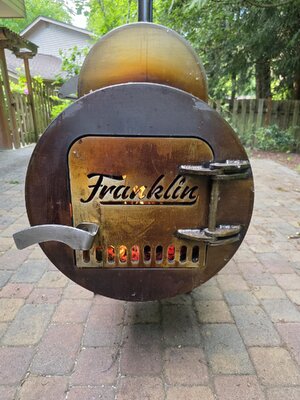
Initiating the fire:
As I said before, I bought some kiln dry hickory wood from Amazon without knowing much about seasoned wood or being very well versed on fire management when it relates to wood. I wanted to have a wood coal base for maximum natural flavor (does it really matter though?) so I started off with a Lincoln cabin. HUGE MISTAKE! Well, not the method itself, but how I built it. I did a 3 level Lincoln cabin... of kiln dry wood... I learned the tough way the difference between naturally seasoned and kiln dry, how much hotter and faster it burns. Took me an hour to get it down from 700+ F. So, my cook started at around 12PM and it was a constant fight with big spikes.
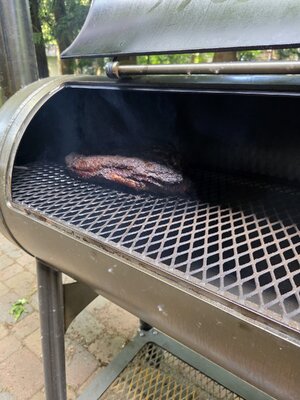
Early cook:
While cooking I was watching at YouTube videos on fire management, huge shutouts to YouTube channels Fatty's Feasts, Meat N' Greet BBQ, Meat Church and Mad Scientist BBQ for having very useful videos! So, my spikes were mostly at around 325F and my cooking average was at 275F. I was going for a bit more of an aggressive cook to get familiar with the smoker and to avoid dips, I felt more confident keeping a fire hot than trying to resuscitate it as I knew I would overblow it. First spray came in at 2h cook time and then spray every 30-45 minutes.
Wrapping Time:
I wrapped at the 9h mark at 175F with a good bark, used beef tallow I had rendered before to keep the moisture content, not much to tell about this part, up until here everything was kinda smooth sailing. The bad thing is that at this point I had used up all 2lbs of my kiln dried hickory wood, and in retrospect I should have finished it in the oven, but I wanted to go all the way in the smoker so I just wrapped and put it back (Sorry for the lack of pictures, I was honestly more worried at this point about learning)
Finishing the cook:
I finished the cook with the brisket wrapped in butcher paper and using some NATURALLY seasoned wood I had in my backyard, now here is my big mistake, I treated it the same way I treated the kiln dry up until this point, so I thought I needed just one log or so and replace every hour or so. BIG mistake, I was struggling to keep the temperature above 220F and every time I tried to manage the fire and make things hotter I would just introduce more cold air. Keep it mind at this point it's 11pm in Seattle area, so it got very cold. I ended up reaching 202F internal at 3.30AM, yeah, I effed up big time my dips at the end when changing types of wood. Lesson learned.
Rest:
I rested my brisket on a Coolman warmed up with boiling water, with a couple damp towels and wrapped in foil to decrease rate of temperature drop, at the 8h mark it reached bellow 140F, so it was time to eat.
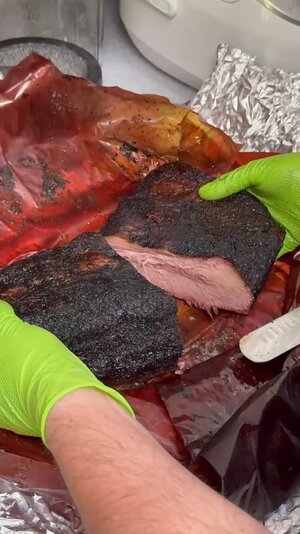

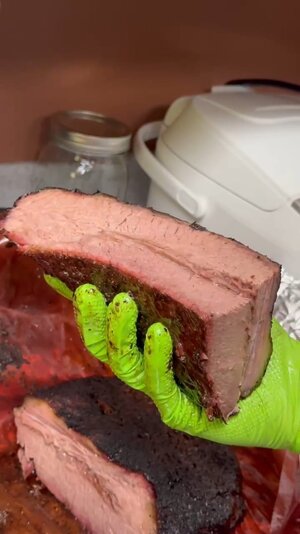
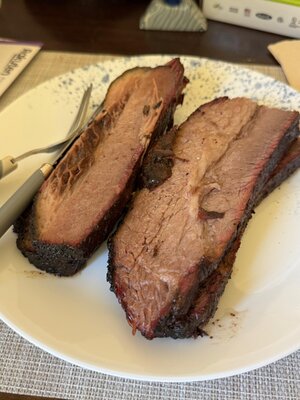
It was very juicy, tender, passed the finger test and the pull test without being overcooked. I feel like the result was very good for a first time but definitely lot of learning to do and improve the process!
Conclusion and final points:
Here's a tl;dr of all the things I learned on this cook, I know all of this was already posted at some point on this forum, but I'm just trying to summarize some of it.
- Start the fire early, around 6 to 8am so that the brisket goes in around 8am, earlier even better.
- Check and double check the seasoning method of the wood, kiln burns hotter and faster, naturally seasoned burns slower and cooler.
- Wood sizes and shape MATTER, a lot, there's a lot of resources online discussing how triangular, thick, heavy, thin logs behave but try to also get a hang of it yourself.
- Don't be too afraid of the spike if you added the correct log, honestly, I fear more the dip.
- TRUST your smoker, the more familiar you are with it, and you see patterns of when temps drop or push, where the hot zones are and so, then everything as spiky as it looks, it's actually predictable.
- There is such a thing as overmanaging your fire, don't be tempted to move the ash around too much as it might choke live embers.
- The ambient temps influence the temps on the cooking chamber, if you live in a cold area that might be significant when fire managing, because the cold air will enter the firebox and the fire might struggle heating up. So, on cold weather a big fire is nothing to be afraid of.
Anyways, lots of these points are meant for beginners, it's muscle memory for most experienced cookers hahaha, but I hope it reminds you of your early stages when learning how to cook to see my struggle, or if you are a beginner yourself it helps to avoid the mistakes I made.
Cheers everyone and keep grillin and chillin.





